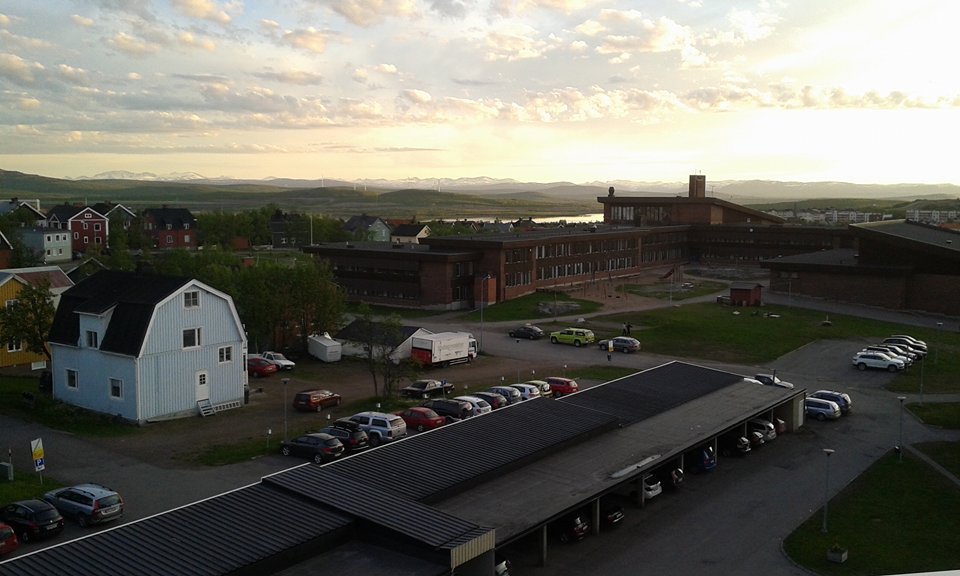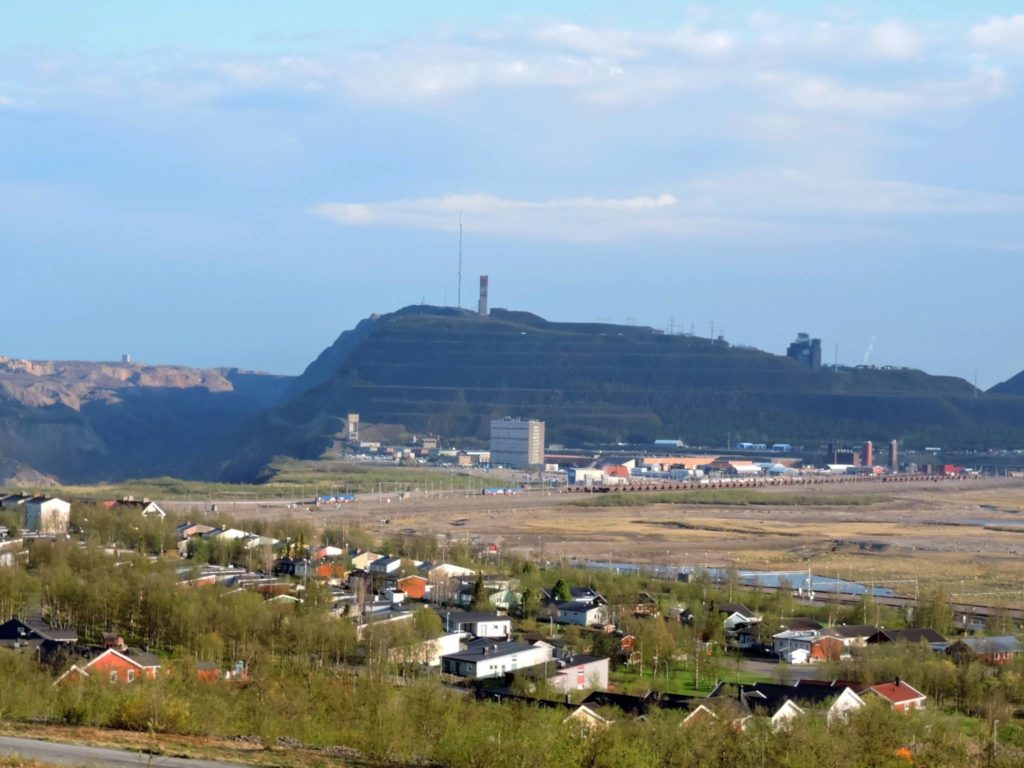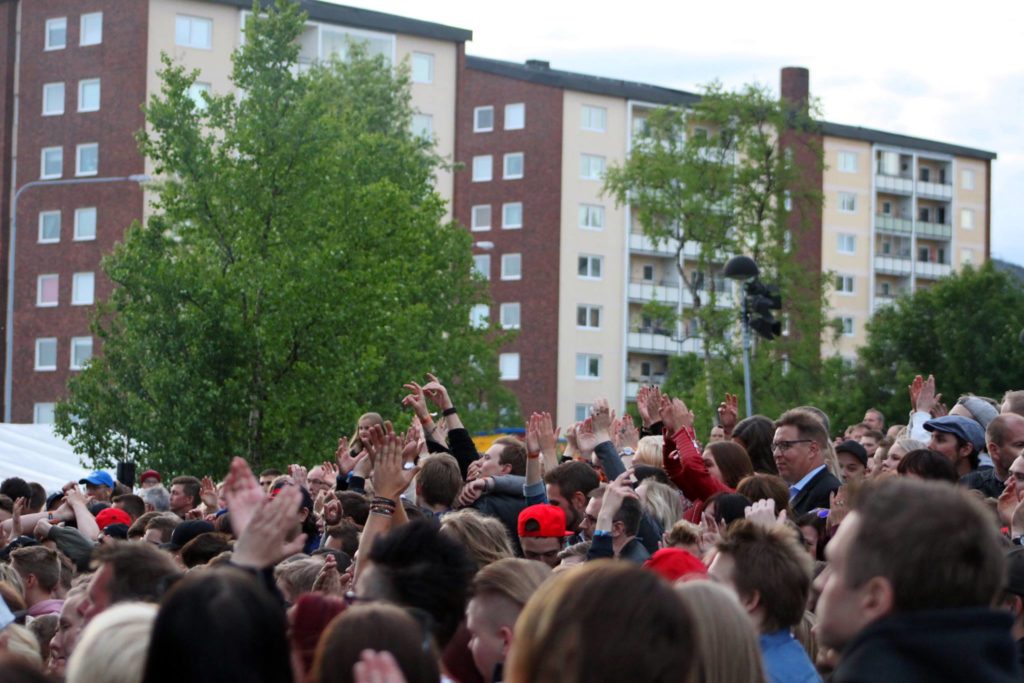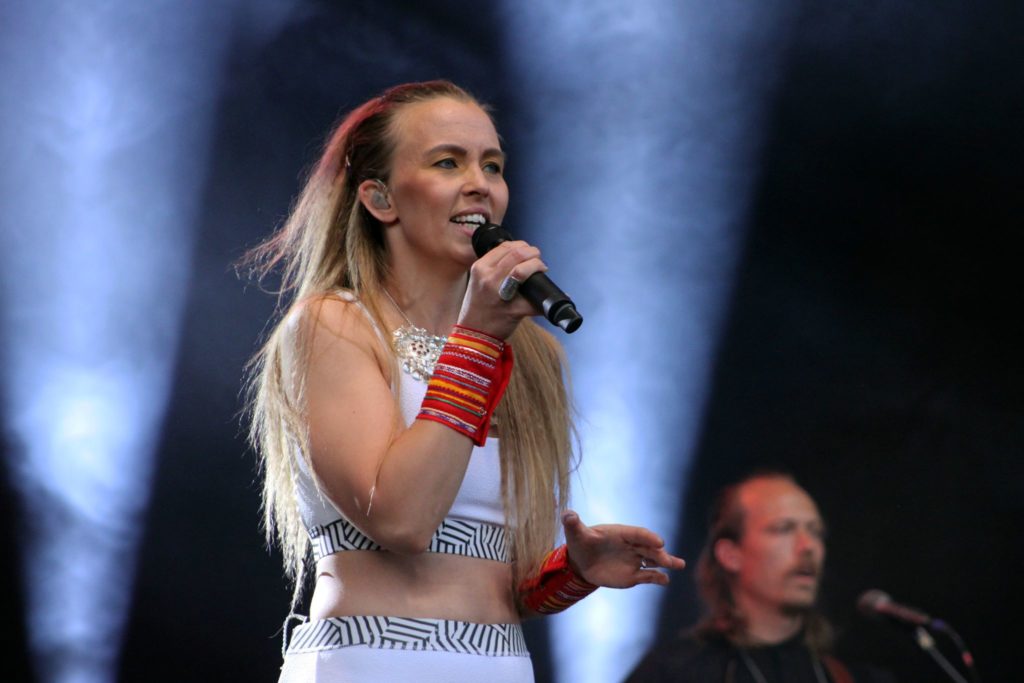
by Rut Elliot Blomqvist
Kiruna/Giron, July 1st, 9 pm. The sun won’t set tonight, nor for another couple of weeks.
The recorded voice of Hans Forssell, a state attorney, booms from the speakers of the festival stage Cityscenen. A group of people are shouting “Jannok, Jannok!”, drowning out the contemptuous, racist crap from a 2016 court case between the Girjas reindeer herding community and the Swedish state.
Sofia Jannok enters the stage to the sound of the cheering audience. Kiruna has been a mining town for 127 years, and the state-owned company LKAB—Luossavaara Kirunavaara Aktiebolag—has long been and is still a key contributor to Swedish state wealth. Jannok’s stage at Kirunafestivalen has a view of both the Kirunavaara/Gironvárri mine and the surrounding mountains and woods where Sámi people lived for about ten thousand years before the crown and state of Sweden took an interest in these lands, and where Tornedalian farming settlements coexisted with Sámi culture for several hundred years before Swedish colonial settlements were established in the 17th century.

Jannok’s drummer hits the snare drum in the march-like intro to the song “This is my land – Sápmi”. Jannok points to the mine and sings: “If you want to ruin it all with big wounds in the mountain, then you’re not worthy listening to this song”. This line leads into a power yoik—yoik being the traditional Sámi vocal style which Jannok mixes with pop music, creating an evocative and original sound—which seems to me to embody both the anger and the joy someone feels when they fight to protect what they love. Her voice and her eyes express grief and loss, and then happiness and love; despair and anger, and then a fierce, euphoric fighting spirit—moving seamlessly between these inseparable feelings. In “I ryggen på min kolt” (“Backstabbing my gákti”), Jannok again points to the mine, singing: “Att sälja landet åt gruvor kallas folkmord”, “To sell the land to mines is called genocide”.
Before the song “Čuđit – Colonizer”, Jannok talks about the last time she arrived at Kiruna airport where she remembers a sign that read “Välkommen till Europas sista vildmark”, “Welcome to the last wilderness of Europe”. She observes that wilderness means unpopulated; the sign at the airport suggests that Sápmi and Tornedalen were empty before they became part of the Swedish state. Jannok says, “there is no wilderness”: “Who do you think named these mountains, in several languages?”. People were living with the land and gave places names in Sámi and Meänkieli (Tornedalian) before others came to colonise the land.
“Čuđit – Colonizer”
Never empty, she was never wild
Stolen cruelly away from her child
Taken care for thousands of years
In seconds she’s ruined seas to seas
Kiruna, or Giron in northern Sámi, means ‘snow grouse.’ Not incidentally, Jannok sings a song called “Snow grouse – Ii leat ivdni mus” which is about surviving:
Invisible though I’ve always been here
Like a snow grouse I fly though they want me to die

To my left, three young people in colourful, patterned gákti—the Sámi regalia—are dancing with a Sámi flag.
Behind them, there are a few older women in blue gákti.
To my right, a middle-aged man is standing alone, dressed in a smart checked shirt, jeans, and a black cap decorated with reindeer and a small Sámi flag. He removes his glasses, to wipe away what seems to be tears.
When I turn around to view the huge crowd, two women behind me who are dressed in contemporary European fashion speak—to me, I think—in a northern Swedish accent, saying “Hon är så jävla bra”, “She’s freaking awesome”.
Closest to the stage by the fence is a line of young girls, many with Sámi handicraft—Duodji—handbags.
A few people in their twenties and thirties, seemingly a bit drunk, are dancing in front of me without paying much heed to the people around them, and two of them know the kids by the fence and sometimes hug and dance with them. Some of the kids don’t seem entirely happy about this.
To the left of the drunken dancers, three people form a kind of line by hugging each other, watching and listening intently to Jannok.
A bit behind me on my right there is a group of people whom I read as queer. One of them is wearing a “don’t assume my gender” t-shirt.
Between two of her songs, Jannok talks about “the strong souls who held on so that I can stand here now”.

Before one of the last songs of the gig, Jannok says, “Whatever happened yesterday, you are still here”. She presents the song through a powerful image: When horrible things happen, you take the hate this awakens and you close your fist around it like around a small stone, and you hold it there until it has become love and then you open your hand and let the love come out. You spread love. That’s how you survive; that’s why diversity and goodness still exist in a colonial world; that’s how we are still here. Then Jannok sings “We are still here – Mii leat dás ain”—which is also the name of the tour.
After “We are still here”, a big group of people near the stage shout what I would venture to guess is “one more time” in Sámi. Someone comments in Swedish that half of Sápmi is there at the gig.
I feel a bit introverted, hiding in my hoodie, wanting to be in a quiet place to think and feel everything Sofia Jannok’s concert has made me think and feel.
I don’t know if the people around me are representative of Sápmi, or of Tornedalen—the Torne river valley—or of Kiruna/Giron. Regardless, these people remind me that there are all kinds of people everywhere: in Gothenburg in the south where I currently live, in Sápmi and Tornedalen, in Kiruna; in an urban core, in Indigenous and other local communities, in a mining town.
I think about something Jannok said during the concert: “I wish that no one would ever have to argue with the state or with anyone else, saying ‘yes, I do exist’”. All of us exist and we are all different. She called the audience her rainbow and sang “Jag är regnbågen på din näthinna”—“I am the rainbow you see”, or “I am your retina’s rainbow”. This is a theme Jannok returns to over and over again, like in “I ryggen på min kolt” which concludes with the words “Colours exist because everyone’s here”.
Leaving the festival, walking back to my father-in-law’s flat in the midnight light, I wonder if anyone wearing a gákti will be harassed or beaten tonight, remembering the line from Jannok’s song “Čuđit – Colonizer”: “Go gávtti biggo šaddá návddiin diggot”, “Wearing your gákti means dealing with beasts”. I wonder if anyone will be sexually harassed or raped tonight—sexual harassment and rape have haunted Swedish festivals this summer, as they have always done. I wonder how many lonely people will get wasted and break down tonight, here in the area called the Vodka belt where talking about your feelings isn’t always a priority. I wonder how many angry, underprivileged men will bond over racist comments about the Sámi and refugees tonight.
I wonder why some people, in particular here in the north, channel their despair, grief, loss, loneliness, and anger in the form of hatred towards the Sámi. That very few Sámi people have minor, relative privileges compared to some other underprivileged groups in the north seems like a simplistic explanation. I wonder if this hatred isn’t also about a kind of jealousy: maybe people envy the Sámi for the Sámi sense of community. I know that, when Jannok sings about her love for the land and her people, I find myself longing for being in a community of people and land.
If a sense of community is what you want, no hatred is going to fill that empty space. Instead of spreading hate, it makes so much more sense to hold it in your fist until it becomes love and then spread that love. It makes so much more sense to build a local community with the people around you; to create your own story about injustice, extractivism, and colonialism; to define what you would demand from the state and other sites of power, and then join the Sámi in their struggle for local autonomy and land rights.
Just outside my father-in-law’s house, from the parking lot, I can see the closed Luossavaara/Luossavárri mine in the distance. The name means Trout mountain. I wonder who gave it that name once. It looks lonely.
Rut Elliot Blomqvist is a songwriter, musician, writer, and PhD student in literature and environmental humanities who thinks a lot about environmental justice, degrowth, and the mythologies of contemporary Western society.